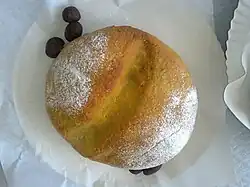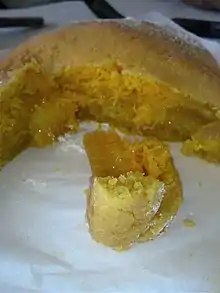Pão de rala
Pão de Rala (lit. 'breadcrumbs') is an historical conventual dessert created by the Poor Clare nuns in the Convento de Santa Helena do Calvário in Évora. It is often accompanied by olives shaped out of marzipan and dusted with cocoa, per legend.[1]
 Accompanied with marzipan "olives" and cocoa. | |
| Type | Conventual dessert |
|---|---|
| Place of origin | Portugal |
| Region or state | Évora, Alentejo |
| Main ingredients | Almond, sugar, egg yolks, doce de gila |
| Ingredients generally used | Lemon or orange zest, cocoa powder |
Pão de Rala is essentially a flourless pastry made to resemble bread. It is made with an almond-based dough similar to marzipan, enriched with egg yolks wrapped around a sweet filling consisting of sugar, fios de ovos (sweet egg yolk threads), and doce de gila (chilacayote jam). Flour is used to assist in shaping the pastry.[2] It was created in commemoration of the visit of King Sebastian to the area.[3][4]
See also
- Portuguese Cuisine – Culinary traditions of Portugal
- Portuguese sweet bread – Various Portuguese sweet breads
References
- "Pão da Rala". Receitas de Portugal (in Portuguese). 9 November 2021. Retrieved 21 October 2023.
- Fernandes, Daniel. "Pão de Rala". Produtos Tradicionais Portugueses. Direção-Geral de Agricultura e Desenvolvimento Rural. Retrieved 15 October 2023.
- "Pão de rala | Traditional Sweet Bread From Évora". www.tasteatlas.com. Retrieved 10 October 2023.
- Barbosa, Ana (15 April 2015). From Farm to Table.: Food and Wine Itineraries. Caminho das Palavras. ISBN 978-989-8784-18-6.
This article is issued from Wikipedia. The text is licensed under Creative Commons - Attribution - Sharealike. Additional terms may apply for the media files.
